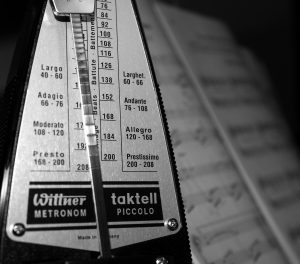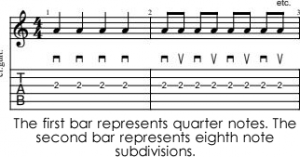Rhythm is the driving force in music. It’s arguably more important than the fretted note.
Play with songs: If you’re a musician, you’re already doing this. First, practise with a recording and then determine how well you can execute the song on your own without any accompaniment. For lead, practise alongside a backing track with real instruments. Simply go to YouTube and search for a backing track that suits the particular style you’re after.
 Focus on your picking: Timing has a lot more to do with the picking (or strumming) hand than the fretted note. You should focus on alternate picking, which is a continuous cycle of alternating upward and downward strokes.
Focus on your picking: Timing has a lot more to do with the picking (or strumming) hand than the fretted note. You should focus on alternate picking, which is a continuous cycle of alternating upward and downward strokes.
Use a metronome: Many musicians agree that using a metronome is the most effective way to develop good timing. There are plenty of free metronomes available. You can use a mobile app, or simply use Google’s built-in metronome. I would encourage you to go even further and get a physical metronome (either mechanical or digital.) This means that you don’t have to sit in front of a PC screen while you’re practising.
You can use a mobile app, or simply use Google’s built-in metronome. I would encourage you to go even further and get a physical metronome (either mechanical or digital.) This means that you don’t have to sit in front of a PC screen while you’re practising.

Playing with a metronome may feel challenging at first. As with any technique, it needs practise. There are plenty of free lessons on YouTube which explore different techniques for practising with a metronome. My personal favorite is a calibration exercise from JustinGuitar, where he shows you how to make the metronome disappear.
Record yourself: On a recording, guitar parts are typically “layered” or “multi-tracked.” This means that you need a good sense of timing in order to layer a part effectively and prevent your playing from sounding sloppy. By recording yourself and then listening back, you will quickly learn to execute your parts in a consistent manner.
 Read music: This is an advanced technique that allows you to practise your timing in fine detail. Technically, this works with tablature too, however I always encourage musicians to learn to read notation. To read music you need some kind of counting mechanism. This is commonly done by counting from 1 to 4 for each beat of the metronome. This represents quarter notes in a single bar of 4/4 music. You can then add subdivisions, typically by using the word “and” between each number count. Robert Callus has created an exercise that will allow you to understand and develop this technique.
Read music: This is an advanced technique that allows you to practise your timing in fine detail. Technically, this works with tablature too, however I always encourage musicians to learn to read notation. To read music you need some kind of counting mechanism. This is commonly done by counting from 1 to 4 for each beat of the metronome. This represents quarter notes in a single bar of 4/4 music. You can then add subdivisions, typically by using the word “and” between each number count. Robert Callus has created an exercise that will allow you to understand and develop this technique.
Play with other musicians: To play well with other musicians, you need to develop a strong independent sense of timing. For some musicians this may naturally occur after practising with recorded songs, however others may have to try a more aggressive approach by utilizing other methods listed above. I read a post from a frustrated teacher, who was struggling with a student that couldn’t understand the basics of a metronome. It was suggested that eurhythmics could help – where bodily movements are used to represent musical rhythms. For example, the student could be instructed to walk around the room at a steady pace while music is played to match the speed of the music.
